ORGB 300: Organizational Behavior and Management Manager Report
VerifiedAdded on 2022/12/28
|10
|1975
|72
Report
AI Summary
This report presents a critical analysis of an interview conducted with a Human Resource Manager, Mr. Brown, at Linda Ltd, exploring his approaches to employee management within the context of organizational behavior. The report examines Brown's strategies for creating satisfied and motivated employees, and reducing employee stress, linking his practices to relevant theories such as Maslow's Hierarchy of Needs and Herzberg's Two-Factor Theory. The report discusses the challenges Brown faces, including attracting talent and managing workplace diversity, and highlights the company's initiatives like team building and employee awards. Ultimately, the report underscores the importance of understanding employee behavior for successful HR management and organizational success.
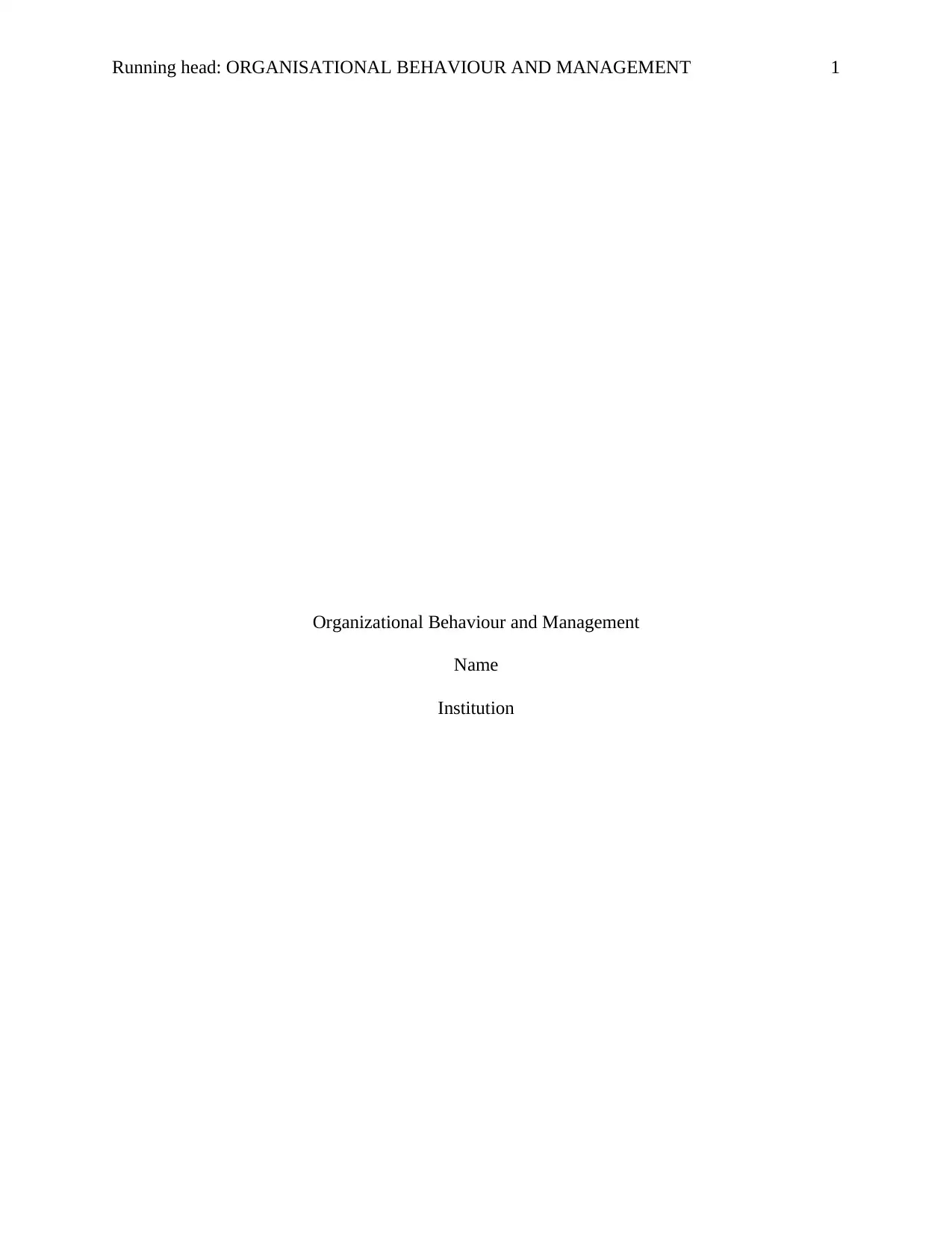
Running head: ORGANISATIONAL BEHAVIOUR AND MANAGEMENT 1
Organizational Behaviour and Management
Name
Institution
Organizational Behaviour and Management
Name
Institution
Paraphrase This Document
Need a fresh take? Get an instant paraphrase of this document with our AI Paraphraser
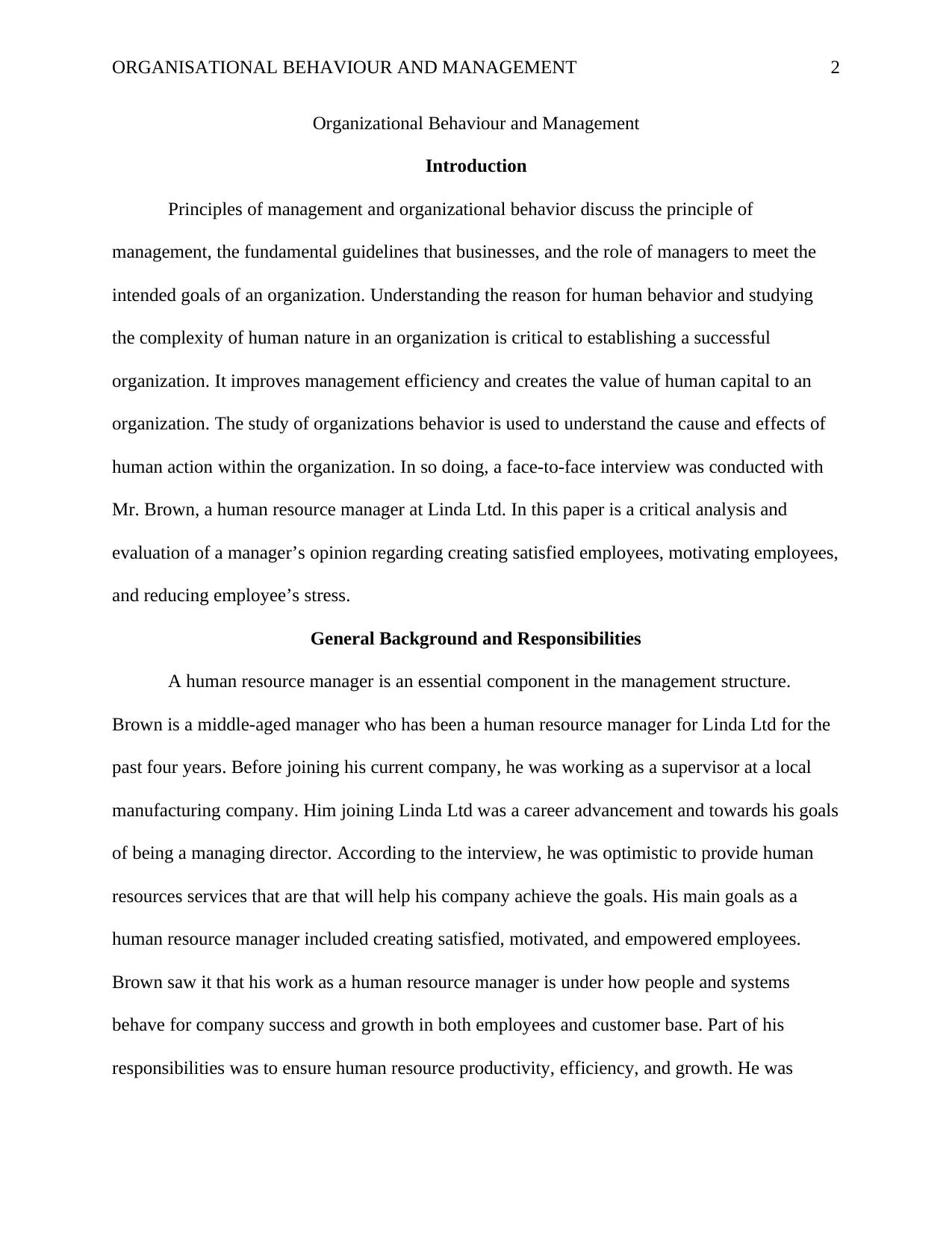
ORGANISATIONAL BEHAVIOUR AND MANAGEMENT 2
Organizational Behaviour and Management
Introduction
Principles of management and organizational behavior discuss the principle of
management, the fundamental guidelines that businesses, and the role of managers to meet the
intended goals of an organization. Understanding the reason for human behavior and studying
the complexity of human nature in an organization is critical to establishing a successful
organization. It improves management efficiency and creates the value of human capital to an
organization. The study of organizations behavior is used to understand the cause and effects of
human action within the organization. In so doing, a face-to-face interview was conducted with
Mr. Brown, a human resource manager at Linda Ltd. In this paper is a critical analysis and
evaluation of a manager’s opinion regarding creating satisfied employees, motivating employees,
and reducing employee’s stress.
General Background and Responsibilities
A human resource manager is an essential component in the management structure.
Brown is a middle-aged manager who has been a human resource manager for Linda Ltd for the
past four years. Before joining his current company, he was working as a supervisor at a local
manufacturing company. Him joining Linda Ltd was a career advancement and towards his goals
of being a managing director. According to the interview, he was optimistic to provide human
resources services that are that will help his company achieve the goals. His main goals as a
human resource manager included creating satisfied, motivated, and empowered employees.
Brown saw it that his work as a human resource manager is under how people and systems
behave for company success and growth in both employees and customer base. Part of his
responsibilities was to ensure human resource productivity, efficiency, and growth. He was
Organizational Behaviour and Management
Introduction
Principles of management and organizational behavior discuss the principle of
management, the fundamental guidelines that businesses, and the role of managers to meet the
intended goals of an organization. Understanding the reason for human behavior and studying
the complexity of human nature in an organization is critical to establishing a successful
organization. It improves management efficiency and creates the value of human capital to an
organization. The study of organizations behavior is used to understand the cause and effects of
human action within the organization. In so doing, a face-to-face interview was conducted with
Mr. Brown, a human resource manager at Linda Ltd. In this paper is a critical analysis and
evaluation of a manager’s opinion regarding creating satisfied employees, motivating employees,
and reducing employee’s stress.
General Background and Responsibilities
A human resource manager is an essential component in the management structure.
Brown is a middle-aged manager who has been a human resource manager for Linda Ltd for the
past four years. Before joining his current company, he was working as a supervisor at a local
manufacturing company. Him joining Linda Ltd was a career advancement and towards his goals
of being a managing director. According to the interview, he was optimistic to provide human
resources services that are that will help his company achieve the goals. His main goals as a
human resource manager included creating satisfied, motivated, and empowered employees.
Brown saw it that his work as a human resource manager is under how people and systems
behave for company success and growth in both employees and customer base. Part of his
responsibilities was to ensure human resource productivity, efficiency, and growth. He was
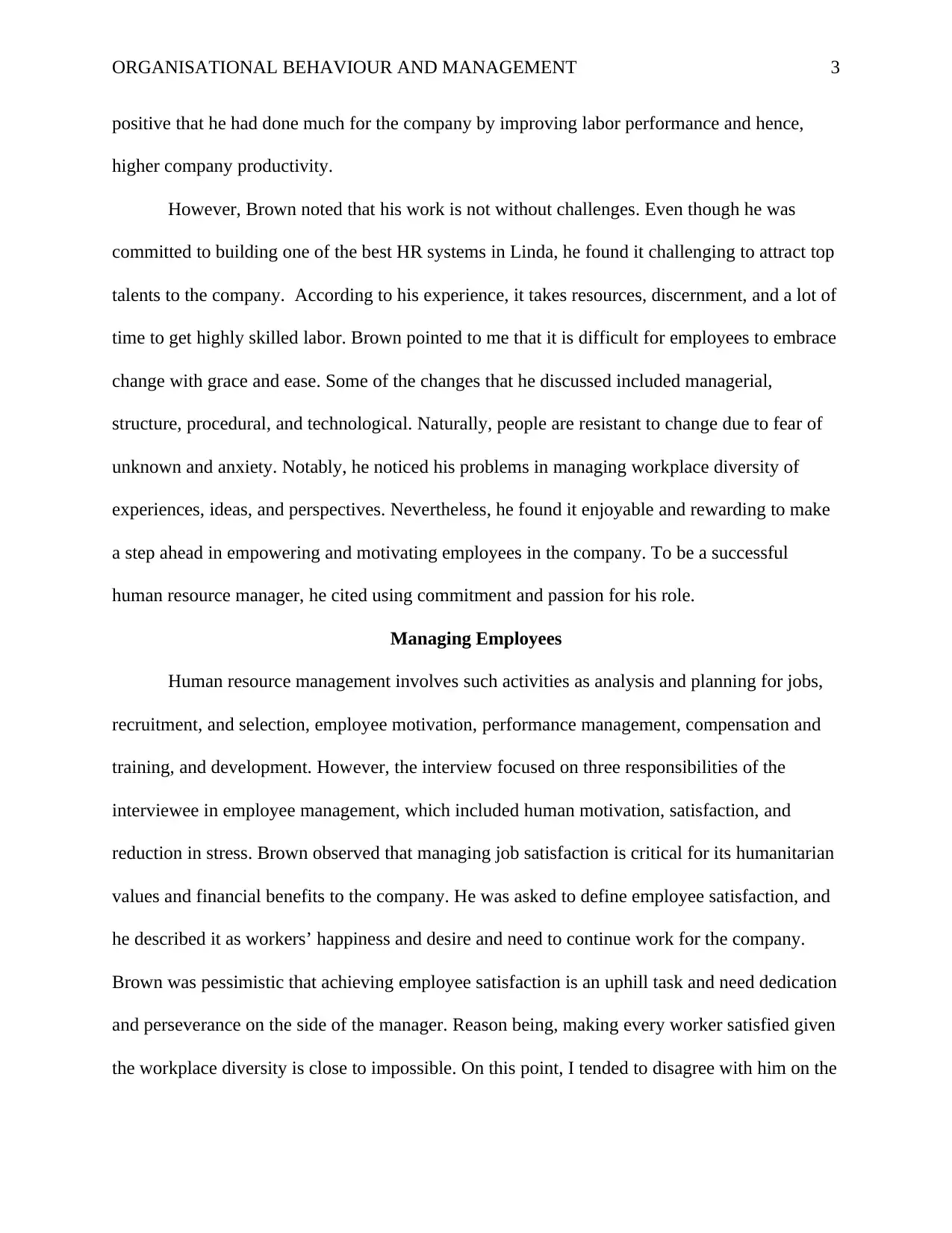
ORGANISATIONAL BEHAVIOUR AND MANAGEMENT 3
positive that he had done much for the company by improving labor performance and hence,
higher company productivity.
However, Brown noted that his work is not without challenges. Even though he was
committed to building one of the best HR systems in Linda, he found it challenging to attract top
talents to the company. According to his experience, it takes resources, discernment, and a lot of
time to get highly skilled labor. Brown pointed to me that it is difficult for employees to embrace
change with grace and ease. Some of the changes that he discussed included managerial,
structure, procedural, and technological. Naturally, people are resistant to change due to fear of
unknown and anxiety. Notably, he noticed his problems in managing workplace diversity of
experiences, ideas, and perspectives. Nevertheless, he found it enjoyable and rewarding to make
a step ahead in empowering and motivating employees in the company. To be a successful
human resource manager, he cited using commitment and passion for his role.
Managing Employees
Human resource management involves such activities as analysis and planning for jobs,
recruitment, and selection, employee motivation, performance management, compensation and
training, and development. However, the interview focused on three responsibilities of the
interviewee in employee management, which included human motivation, satisfaction, and
reduction in stress. Brown observed that managing job satisfaction is critical for its humanitarian
values and financial benefits to the company. He was asked to define employee satisfaction, and
he described it as workers’ happiness and desire and need to continue work for the company.
Brown was pessimistic that achieving employee satisfaction is an uphill task and need dedication
and perseverance on the side of the manager. Reason being, making every worker satisfied given
the workplace diversity is close to impossible. On this point, I tended to disagree with him on the
positive that he had done much for the company by improving labor performance and hence,
higher company productivity.
However, Brown noted that his work is not without challenges. Even though he was
committed to building one of the best HR systems in Linda, he found it challenging to attract top
talents to the company. According to his experience, it takes resources, discernment, and a lot of
time to get highly skilled labor. Brown pointed to me that it is difficult for employees to embrace
change with grace and ease. Some of the changes that he discussed included managerial,
structure, procedural, and technological. Naturally, people are resistant to change due to fear of
unknown and anxiety. Notably, he noticed his problems in managing workplace diversity of
experiences, ideas, and perspectives. Nevertheless, he found it enjoyable and rewarding to make
a step ahead in empowering and motivating employees in the company. To be a successful
human resource manager, he cited using commitment and passion for his role.
Managing Employees
Human resource management involves such activities as analysis and planning for jobs,
recruitment, and selection, employee motivation, performance management, compensation and
training, and development. However, the interview focused on three responsibilities of the
interviewee in employee management, which included human motivation, satisfaction, and
reduction in stress. Brown observed that managing job satisfaction is critical for its humanitarian
values and financial benefits to the company. He was asked to define employee satisfaction, and
he described it as workers’ happiness and desire and need to continue work for the company.
Brown was pessimistic that achieving employee satisfaction is an uphill task and need dedication
and perseverance on the side of the manager. Reason being, making every worker satisfied given
the workplace diversity is close to impossible. On this point, I tended to disagree with him on the
⊘ This is a preview!⊘
Do you want full access?
Subscribe today to unlock all pages.

Trusted by 1+ million students worldwide
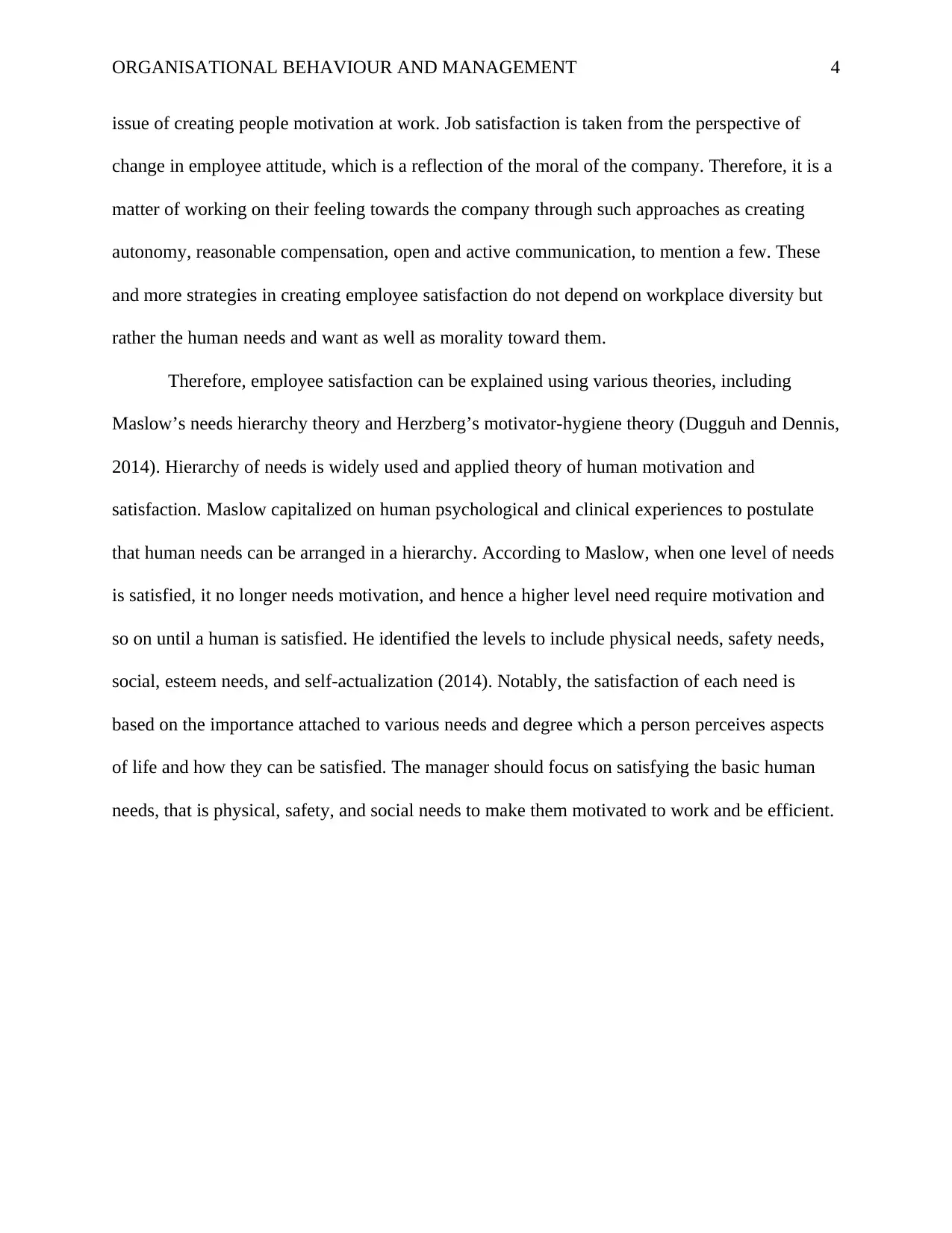
ORGANISATIONAL BEHAVIOUR AND MANAGEMENT 4
issue of creating people motivation at work. Job satisfaction is taken from the perspective of
change in employee attitude, which is a reflection of the moral of the company. Therefore, it is a
matter of working on their feeling towards the company through such approaches as creating
autonomy, reasonable compensation, open and active communication, to mention a few. These
and more strategies in creating employee satisfaction do not depend on workplace diversity but
rather the human needs and want as well as morality toward them.
Therefore, employee satisfaction can be explained using various theories, including
Maslow’s needs hierarchy theory and Herzberg’s motivator-hygiene theory (Dugguh and Dennis,
2014). Hierarchy of needs is widely used and applied theory of human motivation and
satisfaction. Maslow capitalized on human psychological and clinical experiences to postulate
that human needs can be arranged in a hierarchy. According to Maslow, when one level of needs
is satisfied, it no longer needs motivation, and hence a higher level need require motivation and
so on until a human is satisfied. He identified the levels to include physical needs, safety needs,
social, esteem needs, and self-actualization (2014). Notably, the satisfaction of each need is
based on the importance attached to various needs and degree which a person perceives aspects
of life and how they can be satisfied. The manager should focus on satisfying the basic human
needs, that is physical, safety, and social needs to make them motivated to work and be efficient.
issue of creating people motivation at work. Job satisfaction is taken from the perspective of
change in employee attitude, which is a reflection of the moral of the company. Therefore, it is a
matter of working on their feeling towards the company through such approaches as creating
autonomy, reasonable compensation, open and active communication, to mention a few. These
and more strategies in creating employee satisfaction do not depend on workplace diversity but
rather the human needs and want as well as morality toward them.
Therefore, employee satisfaction can be explained using various theories, including
Maslow’s needs hierarchy theory and Herzberg’s motivator-hygiene theory (Dugguh and Dennis,
2014). Hierarchy of needs is widely used and applied theory of human motivation and
satisfaction. Maslow capitalized on human psychological and clinical experiences to postulate
that human needs can be arranged in a hierarchy. According to Maslow, when one level of needs
is satisfied, it no longer needs motivation, and hence a higher level need require motivation and
so on until a human is satisfied. He identified the levels to include physical needs, safety needs,
social, esteem needs, and self-actualization (2014). Notably, the satisfaction of each need is
based on the importance attached to various needs and degree which a person perceives aspects
of life and how they can be satisfied. The manager should focus on satisfying the basic human
needs, that is physical, safety, and social needs to make them motivated to work and be efficient.
Paraphrase This Document
Need a fresh take? Get an instant paraphrase of this document with our AI Paraphraser
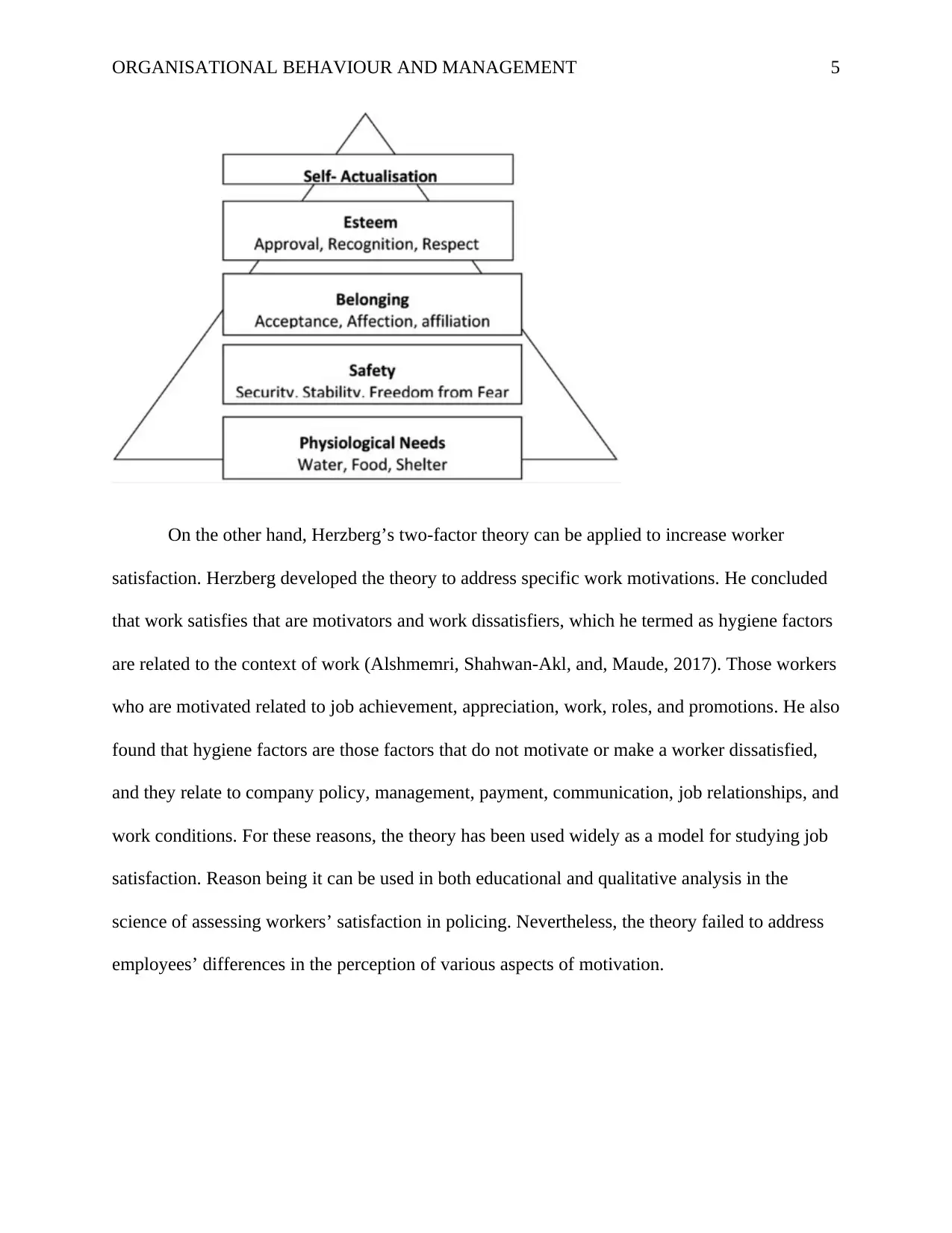
ORGANISATIONAL BEHAVIOUR AND MANAGEMENT 5
On the other hand, Herzberg’s two-factor theory can be applied to increase worker
satisfaction. Herzberg developed the theory to address specific work motivations. He concluded
that work satisfies that are motivators and work dissatisfiers, which he termed as hygiene factors
are related to the context of work (Alshmemri, Shahwan-Akl, and, Maude, 2017). Those workers
who are motivated related to job achievement, appreciation, work, roles, and promotions. He also
found that hygiene factors are those factors that do not motivate or make a worker dissatisfied,
and they relate to company policy, management, payment, communication, job relationships, and
work conditions. For these reasons, the theory has been used widely as a model for studying job
satisfaction. Reason being it can be used in both educational and qualitative analysis in the
science of assessing workers’ satisfaction in policing. Nevertheless, the theory failed to address
employees’ differences in the perception of various aspects of motivation.
On the other hand, Herzberg’s two-factor theory can be applied to increase worker
satisfaction. Herzberg developed the theory to address specific work motivations. He concluded
that work satisfies that are motivators and work dissatisfiers, which he termed as hygiene factors
are related to the context of work (Alshmemri, Shahwan-Akl, and, Maude, 2017). Those workers
who are motivated related to job achievement, appreciation, work, roles, and promotions. He also
found that hygiene factors are those factors that do not motivate or make a worker dissatisfied,
and they relate to company policy, management, payment, communication, job relationships, and
work conditions. For these reasons, the theory has been used widely as a model for studying job
satisfaction. Reason being it can be used in both educational and qualitative analysis in the
science of assessing workers’ satisfaction in policing. Nevertheless, the theory failed to address
employees’ differences in the perception of various aspects of motivation.
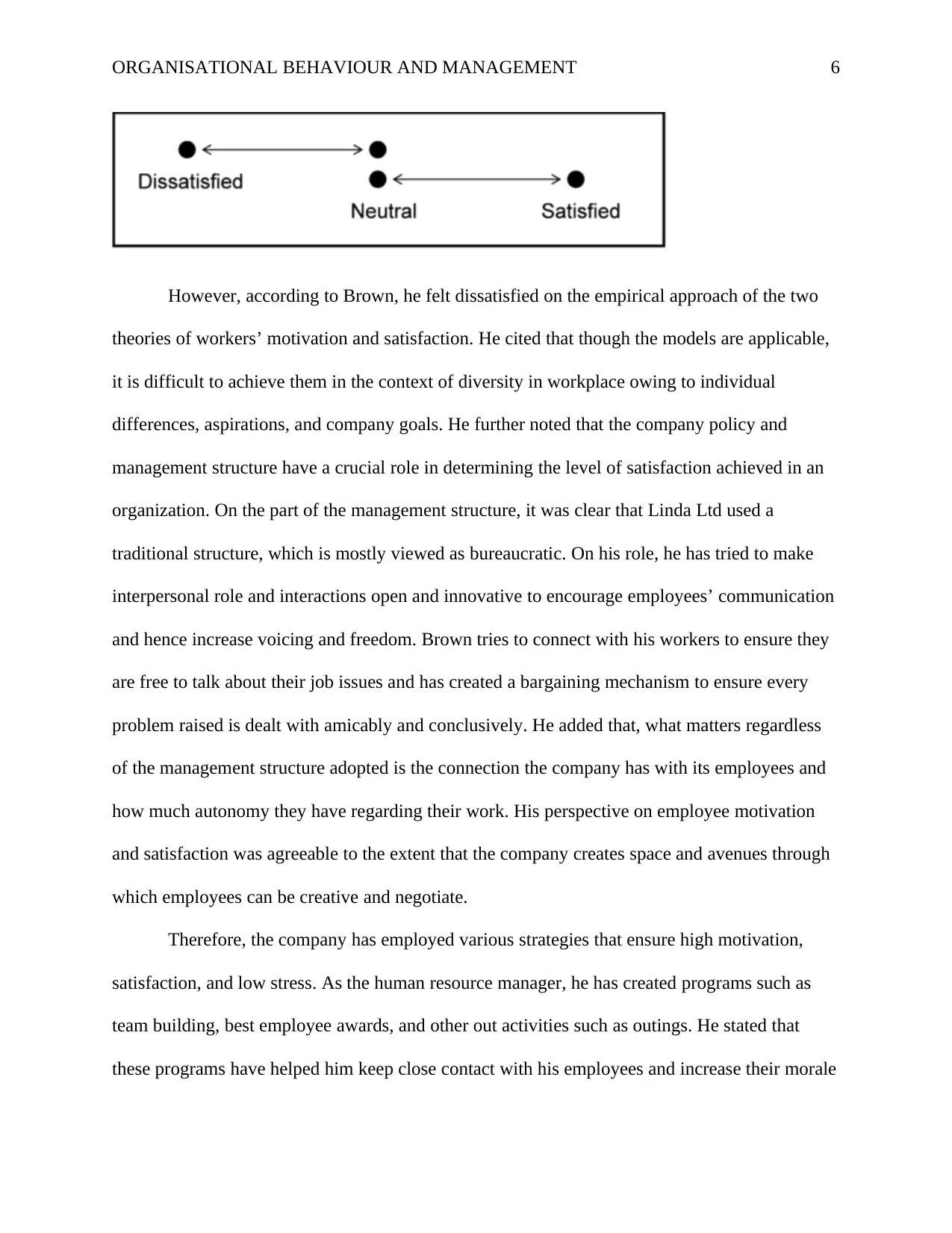
ORGANISATIONAL BEHAVIOUR AND MANAGEMENT 6
However, according to Brown, he felt dissatisfied on the empirical approach of the two
theories of workers’ motivation and satisfaction. He cited that though the models are applicable,
it is difficult to achieve them in the context of diversity in workplace owing to individual
differences, aspirations, and company goals. He further noted that the company policy and
management structure have a crucial role in determining the level of satisfaction achieved in an
organization. On the part of the management structure, it was clear that Linda Ltd used a
traditional structure, which is mostly viewed as bureaucratic. On his role, he has tried to make
interpersonal role and interactions open and innovative to encourage employees’ communication
and hence increase voicing and freedom. Brown tries to connect with his workers to ensure they
are free to talk about their job issues and has created a bargaining mechanism to ensure every
problem raised is dealt with amicably and conclusively. He added that, what matters regardless
of the management structure adopted is the connection the company has with its employees and
how much autonomy they have regarding their work. His perspective on employee motivation
and satisfaction was agreeable to the extent that the company creates space and avenues through
which employees can be creative and negotiate.
Therefore, the company has employed various strategies that ensure high motivation,
satisfaction, and low stress. As the human resource manager, he has created programs such as
team building, best employee awards, and other out activities such as outings. He stated that
these programs have helped him keep close contact with his employees and increase their morale
However, according to Brown, he felt dissatisfied on the empirical approach of the two
theories of workers’ motivation and satisfaction. He cited that though the models are applicable,
it is difficult to achieve them in the context of diversity in workplace owing to individual
differences, aspirations, and company goals. He further noted that the company policy and
management structure have a crucial role in determining the level of satisfaction achieved in an
organization. On the part of the management structure, it was clear that Linda Ltd used a
traditional structure, which is mostly viewed as bureaucratic. On his role, he has tried to make
interpersonal role and interactions open and innovative to encourage employees’ communication
and hence increase voicing and freedom. Brown tries to connect with his workers to ensure they
are free to talk about their job issues and has created a bargaining mechanism to ensure every
problem raised is dealt with amicably and conclusively. He added that, what matters regardless
of the management structure adopted is the connection the company has with its employees and
how much autonomy they have regarding their work. His perspective on employee motivation
and satisfaction was agreeable to the extent that the company creates space and avenues through
which employees can be creative and negotiate.
Therefore, the company has employed various strategies that ensure high motivation,
satisfaction, and low stress. As the human resource manager, he has created programs such as
team building, best employee awards, and other out activities such as outings. He stated that
these programs have helped him keep close contact with his employees and increase their morale
⊘ This is a preview!⊘
Do you want full access?
Subscribe today to unlock all pages.

Trusted by 1+ million students worldwide
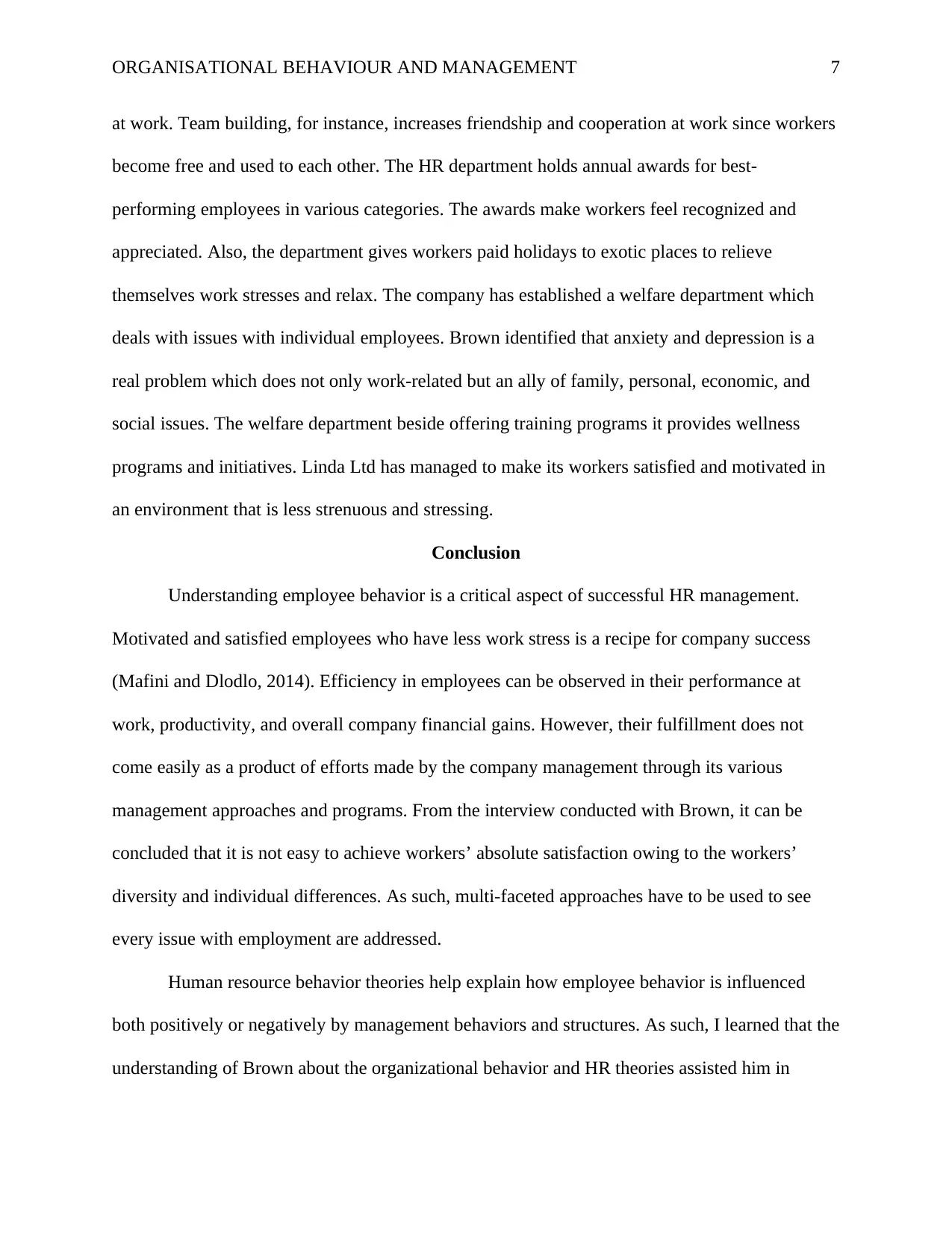
ORGANISATIONAL BEHAVIOUR AND MANAGEMENT 7
at work. Team building, for instance, increases friendship and cooperation at work since workers
become free and used to each other. The HR department holds annual awards for best-
performing employees in various categories. The awards make workers feel recognized and
appreciated. Also, the department gives workers paid holidays to exotic places to relieve
themselves work stresses and relax. The company has established a welfare department which
deals with issues with individual employees. Brown identified that anxiety and depression is a
real problem which does not only work-related but an ally of family, personal, economic, and
social issues. The welfare department beside offering training programs it provides wellness
programs and initiatives. Linda Ltd has managed to make its workers satisfied and motivated in
an environment that is less strenuous and stressing.
Conclusion
Understanding employee behavior is a critical aspect of successful HR management.
Motivated and satisfied employees who have less work stress is a recipe for company success
(Mafini and Dlodlo, 2014). Efficiency in employees can be observed in their performance at
work, productivity, and overall company financial gains. However, their fulfillment does not
come easily as a product of efforts made by the company management through its various
management approaches and programs. From the interview conducted with Brown, it can be
concluded that it is not easy to achieve workers’ absolute satisfaction owing to the workers’
diversity and individual differences. As such, multi-faceted approaches have to be used to see
every issue with employment are addressed.
Human resource behavior theories help explain how employee behavior is influenced
both positively or negatively by management behaviors and structures. As such, I learned that the
understanding of Brown about the organizational behavior and HR theories assisted him in
at work. Team building, for instance, increases friendship and cooperation at work since workers
become free and used to each other. The HR department holds annual awards for best-
performing employees in various categories. The awards make workers feel recognized and
appreciated. Also, the department gives workers paid holidays to exotic places to relieve
themselves work stresses and relax. The company has established a welfare department which
deals with issues with individual employees. Brown identified that anxiety and depression is a
real problem which does not only work-related but an ally of family, personal, economic, and
social issues. The welfare department beside offering training programs it provides wellness
programs and initiatives. Linda Ltd has managed to make its workers satisfied and motivated in
an environment that is less strenuous and stressing.
Conclusion
Understanding employee behavior is a critical aspect of successful HR management.
Motivated and satisfied employees who have less work stress is a recipe for company success
(Mafini and Dlodlo, 2014). Efficiency in employees can be observed in their performance at
work, productivity, and overall company financial gains. However, their fulfillment does not
come easily as a product of efforts made by the company management through its various
management approaches and programs. From the interview conducted with Brown, it can be
concluded that it is not easy to achieve workers’ absolute satisfaction owing to the workers’
diversity and individual differences. As such, multi-faceted approaches have to be used to see
every issue with employment are addressed.
Human resource behavior theories help explain how employee behavior is influenced
both positively or negatively by management behaviors and structures. As such, I learned that the
understanding of Brown about the organizational behavior and HR theories assisted him in
Paraphrase This Document
Need a fresh take? Get an instant paraphrase of this document with our AI Paraphraser
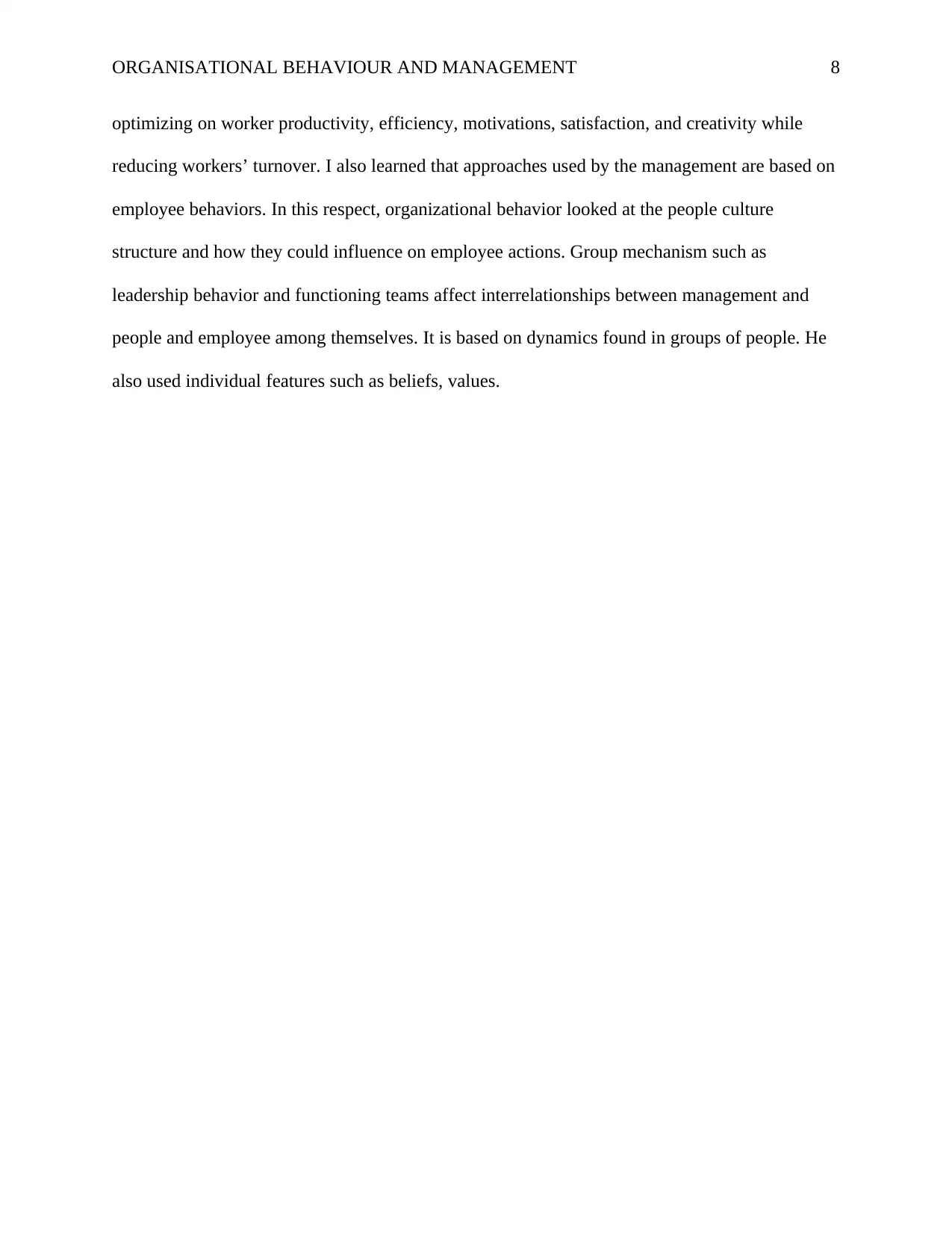
ORGANISATIONAL BEHAVIOUR AND MANAGEMENT 8
optimizing on worker productivity, efficiency, motivations, satisfaction, and creativity while
reducing workers’ turnover. I also learned that approaches used by the management are based on
employee behaviors. In this respect, organizational behavior looked at the people culture
structure and how they could influence on employee actions. Group mechanism such as
leadership behavior and functioning teams affect interrelationships between management and
people and employee among themselves. It is based on dynamics found in groups of people. He
also used individual features such as beliefs, values.
optimizing on worker productivity, efficiency, motivations, satisfaction, and creativity while
reducing workers’ turnover. I also learned that approaches used by the management are based on
employee behaviors. In this respect, organizational behavior looked at the people culture
structure and how they could influence on employee actions. Group mechanism such as
leadership behavior and functioning teams affect interrelationships between management and
people and employee among themselves. It is based on dynamics found in groups of people. He
also used individual features such as beliefs, values.
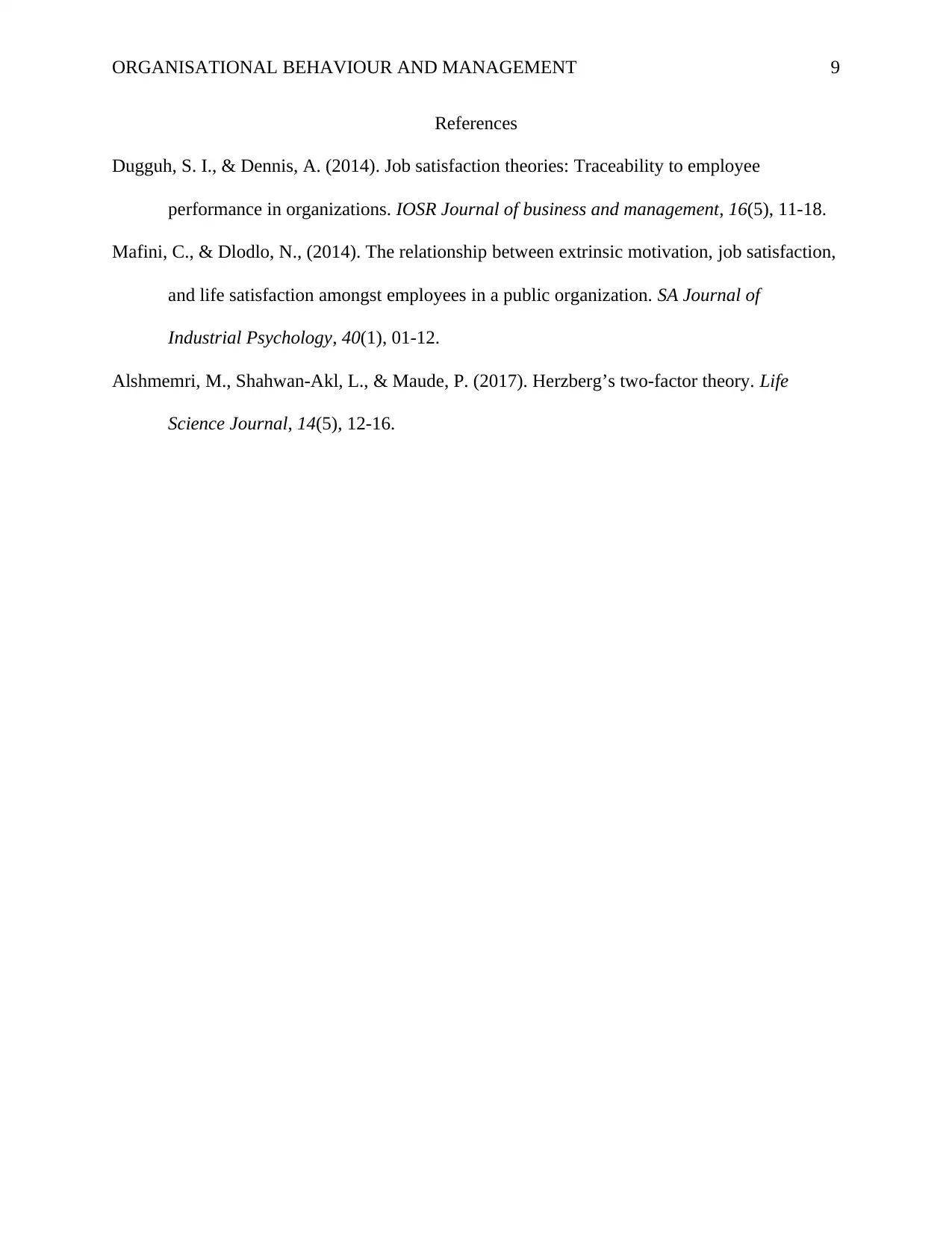
ORGANISATIONAL BEHAVIOUR AND MANAGEMENT 9
References
Dugguh, S. I., & Dennis, A. (2014). Job satisfaction theories: Traceability to employee
performance in organizations. IOSR Journal of business and management, 16(5), 11-18.
Mafini, C., & Dlodlo, N., (2014). The relationship between extrinsic motivation, job satisfaction,
and life satisfaction amongst employees in a public organization. SA Journal of
Industrial Psychology, 40(1), 01-12.
Alshmemri, M., Shahwan-Akl, L., & Maude, P. (2017). Herzberg’s two-factor theory. Life
Science Journal, 14(5), 12-16.
References
Dugguh, S. I., & Dennis, A. (2014). Job satisfaction theories: Traceability to employee
performance in organizations. IOSR Journal of business and management, 16(5), 11-18.
Mafini, C., & Dlodlo, N., (2014). The relationship between extrinsic motivation, job satisfaction,
and life satisfaction amongst employees in a public organization. SA Journal of
Industrial Psychology, 40(1), 01-12.
Alshmemri, M., Shahwan-Akl, L., & Maude, P. (2017). Herzberg’s two-factor theory. Life
Science Journal, 14(5), 12-16.
⊘ This is a preview!⊘
Do you want full access?
Subscribe today to unlock all pages.

Trusted by 1+ million students worldwide
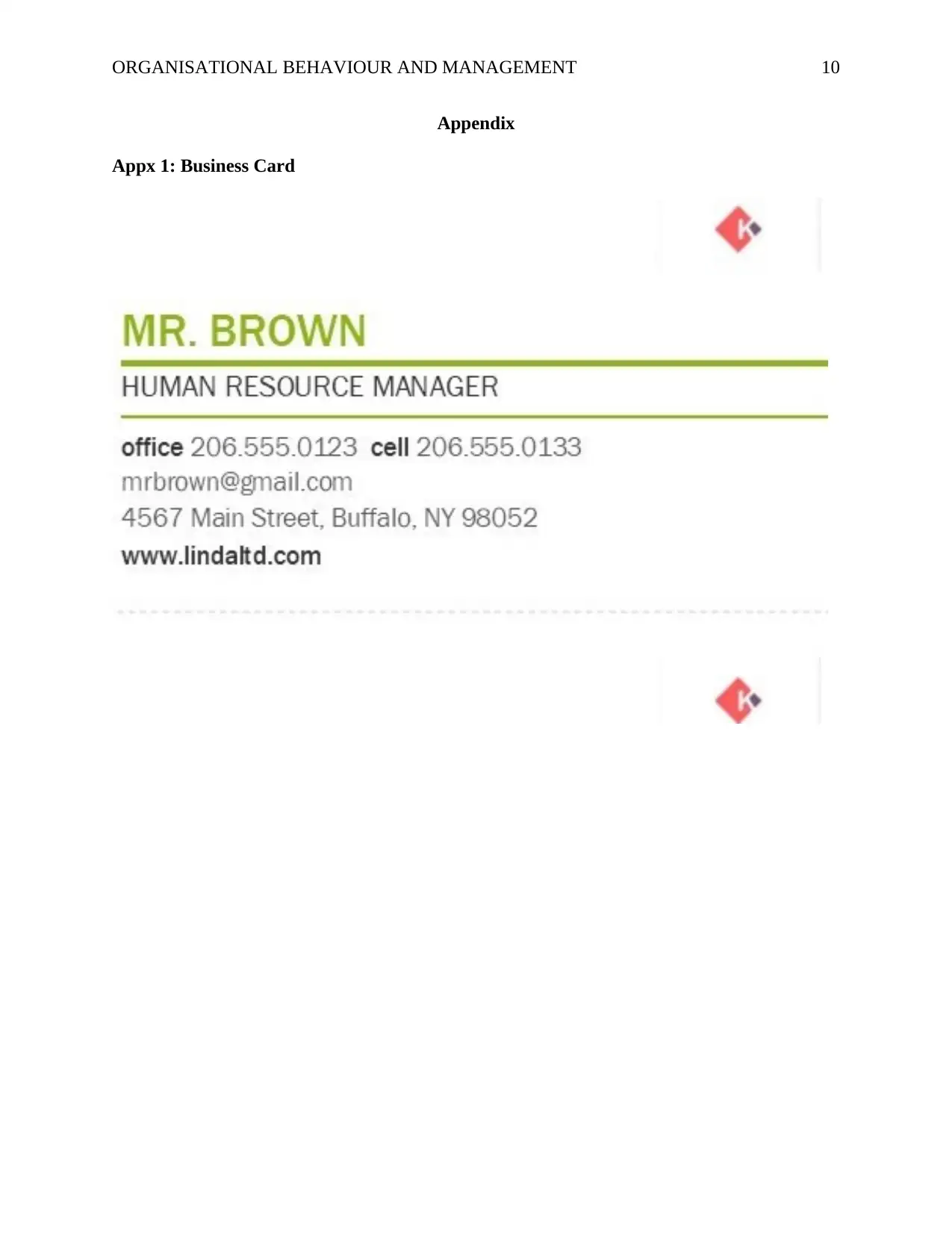
ORGANISATIONAL BEHAVIOUR AND MANAGEMENT 10
Appendix
Appx 1: Business Card
Appendix
Appx 1: Business Card
1 out of 10
Related Documents
Your All-in-One AI-Powered Toolkit for Academic Success.
+13062052269
info@desklib.com
Available 24*7 on WhatsApp / Email
![[object Object]](/_next/static/media/star-bottom.7253800d.svg)
Unlock your academic potential
Copyright © 2020–2025 A2Z Services. All Rights Reserved. Developed and managed by ZUCOL.




